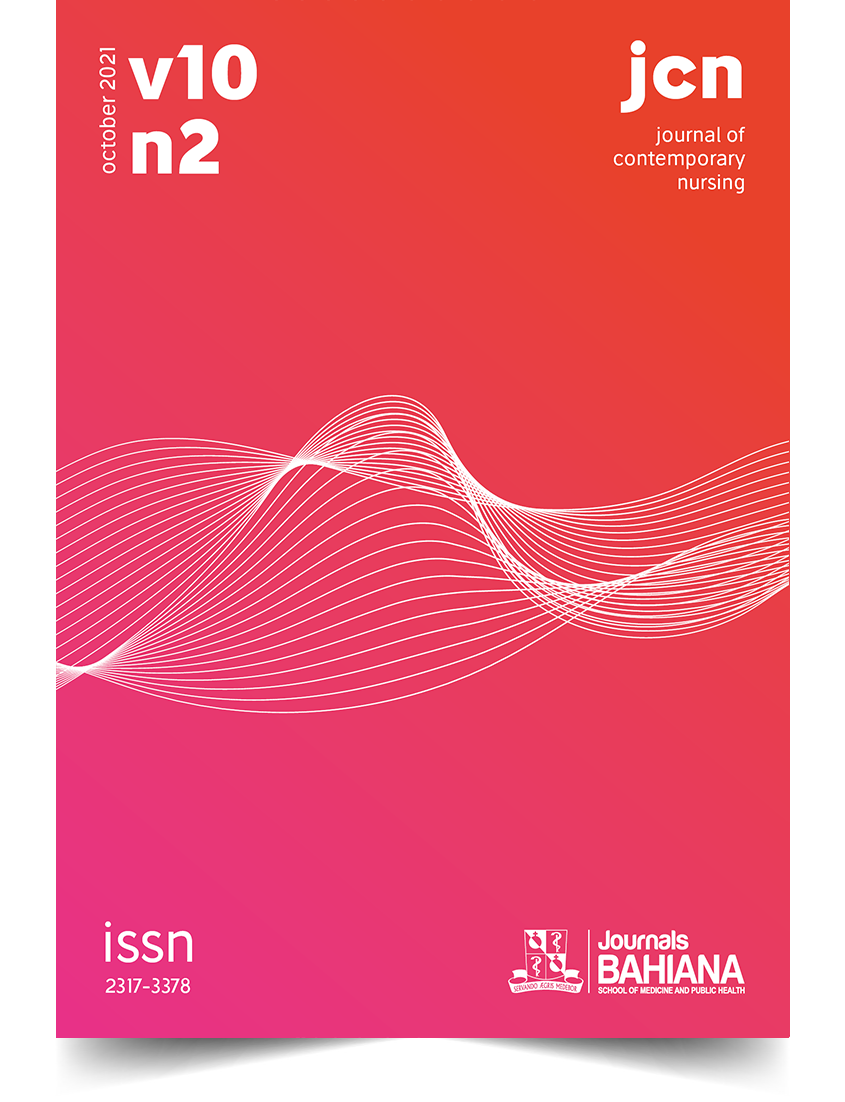Socio-demographic and academic characteristics of nursing students in professional training
DOI:
https://doi.org/10.17267/2317-3378rec.v10i2.3892Keywords:
Nursing Education., College education. , Nursing students.Abstract
OBJECTIVE: To describe nursing students' sociodemographic and academic characteristics from a higher education institution regarding their professional training. METHOD: descriptive, quantitative study, carried out with 197 undergraduate nursing students enrolled in all course periods. Data were collected through a closed, self-administered questionnaire applied from May to August 2017. RESULTS: among nursing students, there was a predominance of females (82.2%), singles (76.1%), with insertion in the formal labor market (49.7%), have children (44.7%), live far from the teaching unit (69%), use public transport to travel to the HEI (82.7%) and uses the internet as the main resource for studies (91.4%). Among the areas of action desired during training, there is assistance and obstetric nursing. CONCLUSION: possible contributions to the structuring of the pedagogical project of the course were verified since the study brings elements that characterize the profile and some academic demands of students who attend the undergraduate nursing course of an educational institution.
Downloads
References
Resolução CNE/CES 3/2001, de 7 de novembro de 2001 (Brazil). Institui Diretrizes Curriculares do Curso de Graduação em Enfermagem. [Internet]. 2001 Nov 7 [cited 2016 Oct 10]. Available from: http: //portal.mec.gov.br/cne/arquivos/pdf/CES03.pdf
Frota MA, Wermelinger MCMW, Vieira LJES, Ximenes Neto FRG, Queiroz RSM, Amorim RF. Mapping nursing training in Brazil: challenges for actions in complex and globalized scenarios. Ciênc. saúde coletiva. 2020;25(1):25-35. https://doi.org/10.1590/1413-81232020251.27672019
Magnago C, Pierantoni CR. Nursing training and their approximation to the assumptions of the National Curriculum Guidelines and Primary Health Care. Ciênc. saúde coletiva. 2020;25(1):15-24. https://doi.org/10.1590/1413-81232020251.28372019.
Marques LMNS. Active methodologies as strategies to develop education in values in nursing graduation. Esc Anna Nery. 2018;22(3):1-6. https://doi.org/10.1590/2177-9465-EAN-2018-0023
Makuch DMV, Zagonel IPS. Pedagogical approach in the implementation of curriculum programs in nurse training. Esc Anna Nery. 2017;21(4):e20170025. https://doi.org/10.1590/2177-9465-EAN-2017-0025
Bublitz S, Guido LA, Kirchhof RS, Neves ET, Lopes LFD. Sociodemographic and academic profile of nursing students from four Brazilian institutions. Rev Gaúcha Enferm. 2015;36(1):77-83. https://doi.org/10.1590/1983-1447.2015.01.48836
Ximenes Neto FRG, Muniz CFF, Dias LJLF, Santos FD, Silva MAM, Oliveira EN. Sociodemographic profile of undergraduate nursing students of the State University Vale do Acaraú (UVA). Enferm Foco. 2017; 8(3):75-9. https://doi.org/10.21675/2357-707X.2017.v8.n3.1532
Colenci R, Berti HW. Professional development and entering the labor market: the perceptions of nursing graduates. Rev esc enferm USP. 2012;46(1):158 -66. https://doi.org/10.1590/S0080-62342012000100022
Leonello NM, Vieira MPM, Duarte TCR. Competencies for educational actions of Family Health Strategy nurses. Rev Bras Enferm. 2018;71(3):1072-8. https://doi.org/10.1590/0034-7167-2017-0390
Siqueira MCG, Leopardi MT. THE TEACHING-LEARNING PROCESS IN TRAINING NHS WORKERS: REFLECTIONS FROM THE EXPERIENCE OF ETSUS. Trab educ saúde. 2016;14(1):114-36. https://doi.org/10.1590/1981-7746-sip00094
Amaral APS, Boery RNSO, Vilela ABA, Sena ELS. Active methodologies:experience report of participationin a specialization course in the Health area. Rev Docência Ens Sup. 2021;11:1-20. https://doi.org/10.35699/2237-5864.2021.24129
Costa LS, Formoso GA Social representations of undergraduates about the education through work for health program. Rev Bras Enferm. 2018;71(2):244-51. https://doi.org/10.1590/0034-7167-2015-0168
Prefeitura Municipal de Salvador (Brazil), Secretaria da Saúde. Plano Municipal de Saúde 2018 – 2021 [Internet]. Salvador: Prefeitura de Salvador; 2018. Available from: http://www.saude.salvador.ba.gov.br/secretaria/informativos-e-documentacoes/
Nascimento PN, Barbosa MCL. Graduates' Perspectives of the Nursing Labor Market. Id on Line Rev Psic [Internet]. 2017;11(35). Available from: https://idonline.emnuvens.com.br/id/article/view/730/0
Machado MH, Koster I, Aguiar Filho W, Wermelinger MCMW, Freire NP, Pereira EJ. Labor market and regulatory processes – Nursing in Brazil. 2020;25(1):101-12. https://doi.org/10.1590/1413-81232020251.27552019
Oliveira ISA, Pires DEP, Alvarez AM, Medeiros SM, Andrade SR. Trends in the job market of nurses in the view of managers. Rev Bras Enferm. 2018;71(1):148-55. https://doi.org/10.1590/0034-7167-2016-0103
Arcêncio RA. Nursing as the profession of the future and the foundation of universal health systems. Rev. Latino-Am. Enfermagem. 2018;26:e3063. https://doi.org/10.1590/1518-8345.0000.3063
Downloads
Published
Issue
Section
License
Copyright (c) 2021 Mari - Saho, Georgina Almeida Lomanto, Isabel Cristina Barros Salviano, Erenice Santos Reis, Karla Ferraz Anjos, Darci Oliveira SantaRosa

This work is licensed under a Creative Commons Attribution 4.0 International License.
This work is licensed under a Creative Commons Attribution 4.0 International License.



